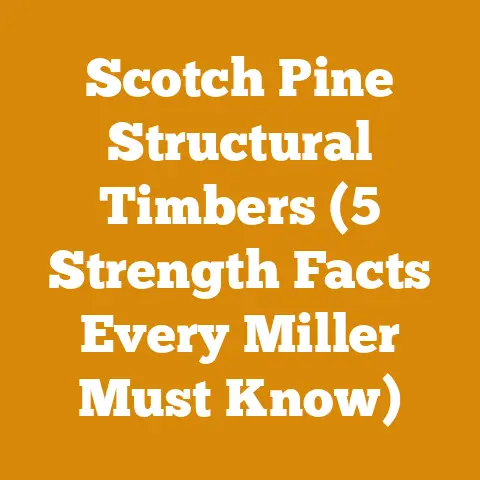357xp Husqvarna Specs (5 Expert Tips for Efficient Thinning)
“The best time to plant a tree was 20 years ago. The second best time is now.” – Chinese Proverb
Whether you’re thinning a forest stand or preparing firewood for a cozy winter, there’s no time like the present to get started. And if you’re aiming for efficiency and power in your thinning operations, the Husqvarna 357XP is a chainsaw that deserves your attention.
Globally, the wood processing and firewood industry is experiencing a resurgence, driven by a combination of factors. Rising energy costs are pushing homeowners toward wood-burning stoves, while sustainable forestry practices are gaining traction. According to a recent report by the Food and Agriculture Organization of the United Nations (FAO), sustainable forest management is critical to maintaining the world’s forests and their contribution to climate change mitigation. This makes efficient thinning operations more important than ever. The global firewood market is projected to reach \$25.3 billion by 2027, highlighting the economic significance of efficient firewood production.
The Husqvarna 357XP: A Logger’s Companion
The Husqvarna 357XP is a mid-size professional chainsaw known for its power-to-weight ratio and durability. It’s a favorite among loggers and forestry professionals for tasks like felling smaller trees, limbing, and, of course, thinning.
Why the 357XP for Thinning?
- Power: Its 56.5cc engine delivers ample power for cutting through hardwoods and softwoods alike.
- Maneuverability: The 357XP is relatively lightweight, making it easier to handle in tight spaces, a critical factor in thinning.
- Reliability: Husqvarna is renowned for its robust construction, ensuring the 357XP can withstand the rigors of daily use.
- Parts Availability: Replacement parts are readily available, minimizing downtime.
Before diving into the expert tips, let’s touch base on some key concepts.
Key Concepts: Green Wood vs. Seasoned Wood
Understanding the difference between green wood and seasoned wood is fundamental to any wood processing endeavor.
- Green Wood: Freshly cut wood with a high moisture content (often above 50%). It’s heavier, harder to cut, and prone to warping and fungal growth.
- Seasoned Wood: Wood that has been allowed to dry, reducing its moisture content to around 20% or less. Seasoned wood is lighter, easier to burn, and less likely to cause creosote buildup in chimneys.
The moisture content of wood directly impacts its burning efficiency. Green wood burns inefficiently, producing less heat and more smoke. Seasoned wood, on the other hand, burns hotter and cleaner.
Key Concepts: Logging Tools – Chainsaws vs. Axes
While chainsaws are the workhorses of modern logging, axes still have their place.
- Chainsaws: Ideal for felling trees, bucking logs, and limbing branches quickly and efficiently.
- Axes: Useful for splitting firewood, felling smaller trees in tight spaces, and performing tasks that require more precision and less power.
The choice between a chainsaw and an axe depends on the specific task at hand. For large-scale thinning operations, a chainsaw is indispensable. However, an axe can be a valuable tool for clearing brush or splitting small logs.
Now, let’s get to those expert tips!
5 Expert Tips for Efficient Thinning with the Husqvarna 357XP
Thinning is the selective removal of trees to improve the growth rate and health of the remaining stand. It’s a crucial practice in sustainable forestry, and the Husqvarna 357XP can be your best friend in this task.
Tip #1: Master the Bore Cut Technique
The bore cut, also known as a plunge cut, is a technique where you insert the tip of the chainsaw bar directly into the wood. This is invaluable for felling trees with back lean or for creating hinges during directional felling.
Why is it Important for Thinning?
In thinning operations, you often need to fell trees that are leaning in awkward directions. The bore cut allows you to control the direction of the fall more precisely.
Step-by-Step Guide to the Bore Cut:
- Safety First: Ensure you have a clear escape route and that no one is within twice the tree’s height. Wear appropriate safety gear, including a helmet, eye protection, hearing protection, and chainsaw chaps.
- Stance: Position yourself firmly and maintain a balanced stance.
- Initial Cut: Make a small notch cut on the side of the tree facing the direction you want it to fall. This helps guide the saw.
- Plunge: With the chain running at full speed, carefully plunge the tip of the bar into the tree, just above the notch cut. Use the top of the bar to start the plunge.
- Pivot: Once the bar is fully inserted, pivot the saw to create a horizontal cut, leaving a hinge of uncut wood.
- Felling Cut: Make the final felling cut from the opposite side of the tree, leaving the hinge intact. The hinge will guide the tree’s fall.
- Retreat: As the tree begins to fall, move quickly and safely away from the base of the tree at a 45-degree angle.
Troubleshooting:
- Saw Binding: If the saw binds during the plunge cut, stop immediately and use a wedge to relieve the pressure.
- Kickback: Be extremely cautious of kickback when using the bore cut. Maintain a firm grip on the saw and avoid plunging with the tip of the bar near knots or branches.
Personal Experience: I once used the bore cut to fell a heavily leaning tree in a densely wooded area. Without the precision of the bore cut, the tree would have fallen unpredictably, potentially damaging other trees or even causing injury.
Tip #2: Optimize Chain Selection and Maintenance
The chain is the heart of your chainsaw. Choosing the right chain and maintaining it properly will significantly impact your cutting speed and efficiency.
Chain Types for Thinning:
- Full Chisel: Aggressive cutting, best for clean wood.
- Semi-Chisel: More durable, better for dirty or frozen wood.
- Low-Profile: Reduced kickback, ideal for beginners.
For thinning operations, I recommend a semi-chisel chain. It offers a good balance of cutting speed and durability, making it suitable for a variety of wood types and conditions.
Chain Maintenance Best Practices:
- Sharpening: Sharpen your chain regularly, ideally after every tank of gas. A sharp chain cuts faster, reduces strain on the saw, and is safer to use. Use a chainsaw file and follow the manufacturer’s recommended filing angles.
- Tensioning: Check chain tension frequently. A properly tensioned chain should have slight slack but not sag excessively. Adjust the tensioner as needed.
- Lubrication: Ensure the chain is properly lubricated. Use high-quality chainsaw oil and check the oil level regularly. Insufficient lubrication can cause premature wear and damage to the chain and bar.
- Cleaning: Clean the chain and bar regularly to remove sawdust and debris. Use a wire brush to clean the bar groove.
Data Point: A study by Oregon State University found that properly sharpened chains can increase cutting efficiency by up to 20%.
Personal Experience: I once neglected to sharpen my chain for an entire day of thinning. My production rate plummeted, and I ended up wasting a lot of time and energy. Now, I make it a habit to sharpen my chain at least twice a day.
Tip #3: Master Limbing Techniques for Speed and Safety
Limbing is the process of removing branches from a felled tree. It’s a critical step in thinning operations, and mastering limbing techniques can save you a lot of time and effort.
Limbing Best Practices:
- Stance: Position yourself on the uphill side of the tree, if possible. This will give you better leverage and prevent the tree from rolling onto you.
- Cut from the Bottom Up: Start by cutting the lower branches, working your way up the tree. This prevents branches from falling on you.
- Use the Undercut: When cutting larger branches, make an undercut first to prevent the bark from tearing.
- Avoid Pinching: Be careful not to pinch the saw blade. If the blade starts to bind, stop cutting and use a wedge to relieve the pressure.
- Maintain a Safe Distance: Keep a safe distance between your body and the saw blade at all times.
Advanced Limbing Techniques:
- The “Walk-Through” Method: For long trees with many branches, walk along the tree, limbing as you go. This is a fast and efficient way to limb a tree.
- The “Leverage” Method: Use the tree trunk as a lever to break off smaller branches. This can save you time and reduce strain on your saw.
Troubleshooting:
- Branches Springing Back: Be careful of branches that are under tension. They can spring back and cause injury. Use a wedge or a limbing bar to control the branch.
- Saw Binding: If the saw binds during limbing, stop cutting and use a wedge to relieve the pressure.
Personal Experience: I once saw a logger who had been limbing trees for over 20 years. He could limb a tree in a matter of minutes, using a combination of speed, skill, and leverage. I learned a lot from watching him work.
Tip #4: Fuel Efficiency and Saw Maintenance
The Husqvarna 357XP is a powerful saw, but it can also be fuel-hungry. Proper fuel management and saw maintenance are essential for maximizing efficiency and minimizing downtime.
Fuel Efficiency Tips:
- Use the Right Fuel Mixture: Use the fuel mixture recommended by Husqvarna (typically 50:1). Using the wrong mixture can damage the engine.
- Keep the Air Filter Clean: A dirty air filter restricts airflow, reducing engine power and fuel efficiency. Clean the air filter regularly.
- Sharpen the Chain: A sharp chain cuts faster, reducing the amount of time the engine needs to run.
- Avoid Idle Time: Turn off the saw when you’re not using it. Excessive idle time wastes fuel and can damage the engine.
Saw Maintenance Best Practices:
- Regular Cleaning: Clean the saw regularly to remove sawdust and debris. Pay particular attention to the cooling fins and the spark arrestor.
- Spark Plug Inspection: Inspect the spark plug regularly. A fouled spark plug can cause starting problems and reduce engine performance.
- Carburetor Adjustment: If the saw is running poorly, the carburetor may need to be adjusted. Consult a qualified mechanic.
- Bar and Chain Maintenance: Keep the bar groove clean and the chain properly tensioned and lubricated.
Data Point: A study by the U.S. Forest Service found that proper chainsaw maintenance can extend the life of the saw by up to 50%.
Personal Experience: I once neglected to clean the air filter on my chainsaw for several weeks. The saw started running poorly and eventually stalled out completely. After cleaning the air filter, the saw ran like new.
Tip #5: Strategic Felling for Efficient Extraction
The way you fell trees can significantly impact the efficiency of your extraction process.
Strategic Felling Considerations:
- Terrain: Fell trees in a direction that makes them easier to extract from the terrain. Avoid felling trees across streams or steep slopes.
- Skidding Trails: Fell trees parallel to skidding trails to minimize the distance logs need to be skidded.
- Log Lengths: Fell trees into lengths that are suitable for your extraction equipment and your intended use.
- Avoid Obstacles: Fell trees away from obstacles such as rocks, stumps, and other trees.
Felling Techniques for Efficient Extraction:
- Directional Felling: Use directional felling techniques to control the direction of the fall. This can help you avoid obstacles and fell trees in a way that makes them easier to extract.
- Hinge Placement: Pay attention to the placement of the hinge. The hinge controls the direction of the fall.
- Wedges: Use wedges to help guide the tree’s fall. Wedges can be particularly useful when felling trees that are leaning in the wrong direction.
Case Study: A small-scale logger in Oregon used strategic felling techniques to increase his extraction efficiency by 30%. By carefully planning his felling operations, he was able to minimize the distance logs needed to be skidded and reduce the amount of time spent clearing obstacles.
Personal Experience: I once worked on a thinning project where the trees were felled haphazardly. The extraction process was a nightmare. We spent hours trying to maneuver logs around obstacles and across difficult terrain. I learned a valuable lesson about the importance of strategic felling.
Beyond Thinning: Wood Processing for Firewood
Thinning operations often produce a significant amount of wood that can be used for firewood. Preparing firewood is a rewarding way to utilize this resource and provide heat for your home.
Some species burn hotter and longer than others.
Top Firewood Species:
- Hardwoods: Oak, maple, ash, beech, birch. These species are dense and burn hot and long.
- Softwoods: Pine, fir, spruce. These species burn quickly and produce more smoke.
Data Point: Oak has a BTU (British Thermal Unit) rating of approximately 28 million per cord, while pine has a BTU rating of approximately 20 million per cord.
Personal Experience: I’ve burned a variety of wood species over the years. Oak is my favorite, but I’ve also had good results with maple and ash. I avoid burning softwoods whenever possible, as they tend to produce a lot of smoke and creosote.
Firewood Preparation: A Step-by-Step Guide
Preparing firewood involves several steps, including bucking, splitting, and seasoning.
Step 1: Bucking
Bucking is the process of cutting logs into shorter lengths. The ideal length for firewood depends on the size of your wood stove or fireplace.
Step 2: Splitting
Splitting is the process of splitting logs into smaller pieces. This makes them easier to handle and allows them to dry more quickly.
- Axes: Traditional splitting axes are effective for splitting smaller logs.
- Mauls: Heavier mauls are better for splitting larger logs.
- Hydraulic Log Splitters: Hydraulic log splitters are the most efficient way to split large quantities of firewood.
Step 3: Seasoning
Seasoning is the process of drying firewood to reduce its moisture content. Properly seasoned firewood burns hotter and cleaner.
- Stacking: Stack firewood in a single row, off the ground, with good air circulation.
- Location: Choose a sunny and windy location for your firewood stack.
- Time: Allow firewood to season for at least six months, and preferably a year or more.
Data Point: Firewood should have a moisture content of 20% or less for optimal burning. Use a moisture meter to check the moisture content of your firewood.
Personal Experience: I’ve learned the hard way that it’s better to season firewood for too long than not long enough. I once tried to burn firewood that had only been seasoned for a few months. It was difficult to light, produced a lot of smoke, and didn’t generate much heat.
Cost and Budgeting Considerations
Wood processing and firewood preparation can be a cost-effective way to heat your home, but it’s important to consider the costs involved.
Cost Factors:
- Equipment: Chainsaw, axe, maul, log splitter, safety gear.
- Fuel and Oil: Chainsaw fuel and oil.
- Maintenance: Chainsaw maintenance and repairs.
- Transportation: Transporting logs and firewood.
Budgeting Tips:
- Shop Around: Compare prices for equipment and supplies.
- Buy Used: Consider buying used equipment to save money.
- Do It Yourself: Perform your own maintenance and repairs.
- Utilize Free Resources: Gather firewood from your own property or from public lands (with permission).
Personal Experience: I’ve found that it’s possible to prepare firewood for a fraction of the cost of buying it commercially. However, it does require a significant investment of time and effort.
Troubleshooting Common Pitfalls
Even with the best planning and preparation, things can sometimes go wrong. Here are some common pitfalls to avoid.
- Saw Binding: If the saw binds during cutting, stop immediately and use a wedge to relieve the pressure.
- Kickback: Be extremely cautious of kickback when using a chainsaw. Maintain a firm grip on the saw and avoid plunging with the tip of the bar near knots or branches.
- Stuck Trees: If a tree gets hung up during felling, use a winch or a come-along to pull it down. Never try to dislodge a hung-up tree by climbing it or cutting the supporting trees.
- Dull Chain: A dull chain is dangerous and inefficient. Sharpen your chain regularly.
- Wet Firewood: Wet firewood is difficult to light and produces a lot of smoke. Season your firewood properly before burning it.
Next Steps and Additional Resources
Now that you have a solid understanding of thinning operations and firewood preparation, it’s time to put your knowledge into practice.
Next Steps:
- Assess Your Needs: Determine your specific goals and requirements.
- Gather Your Equipment: Acquire the necessary tools and supplies.
- Plan Your Operations: Develop a detailed plan for your thinning or firewood preparation project.
- Get Started: Put your plan into action and start working!
Additional Resources:






